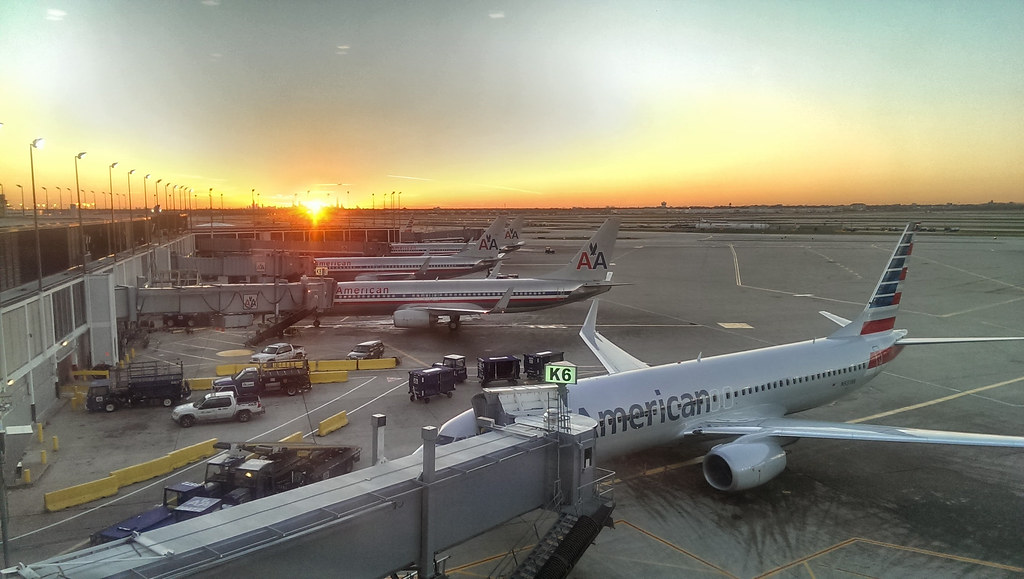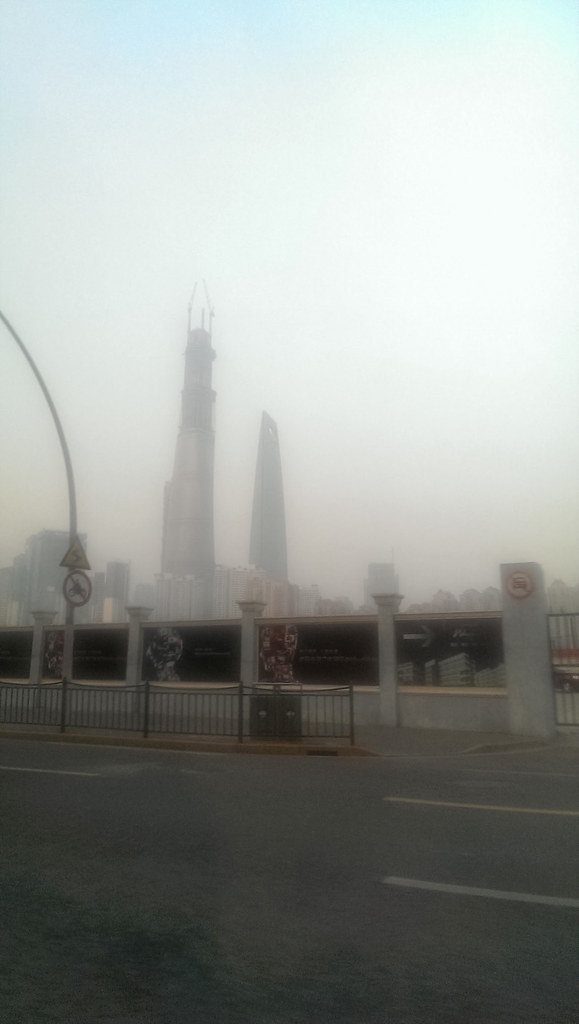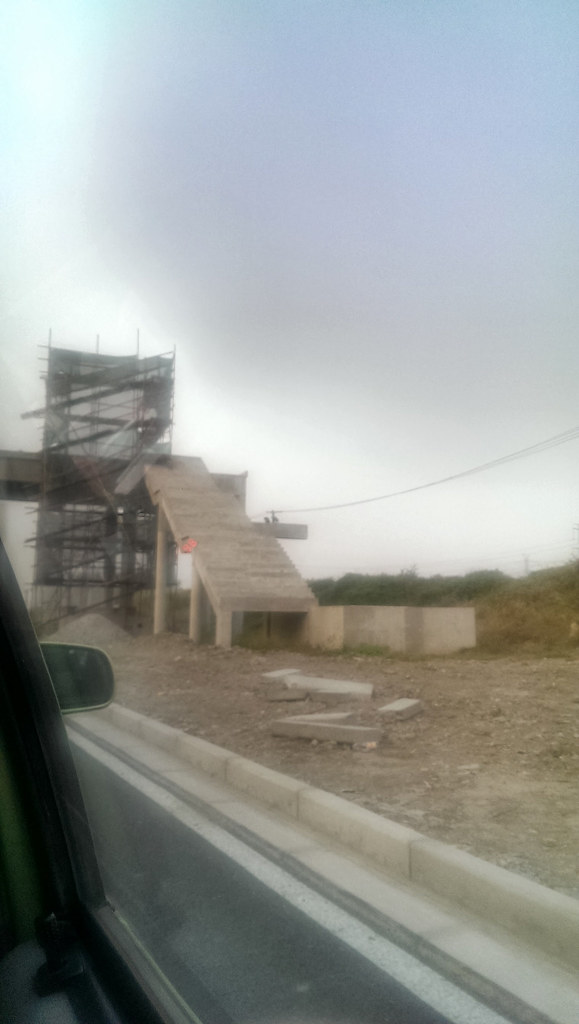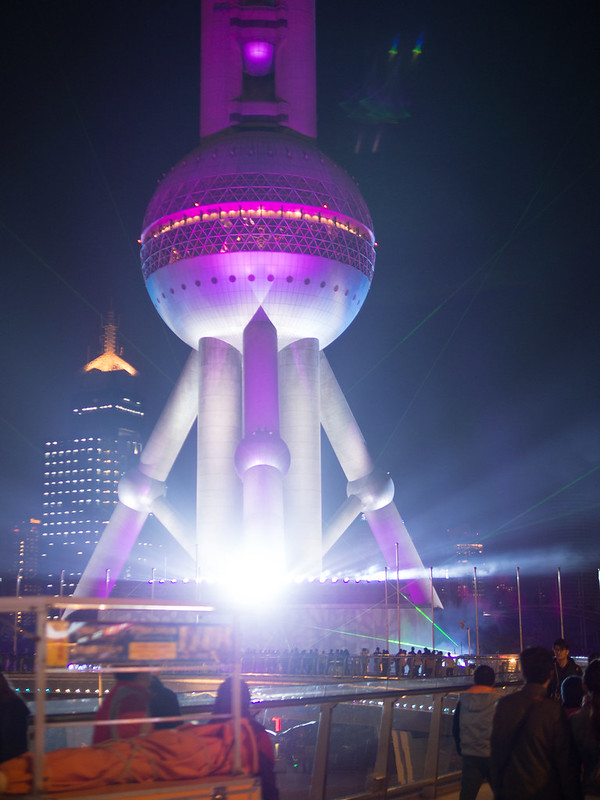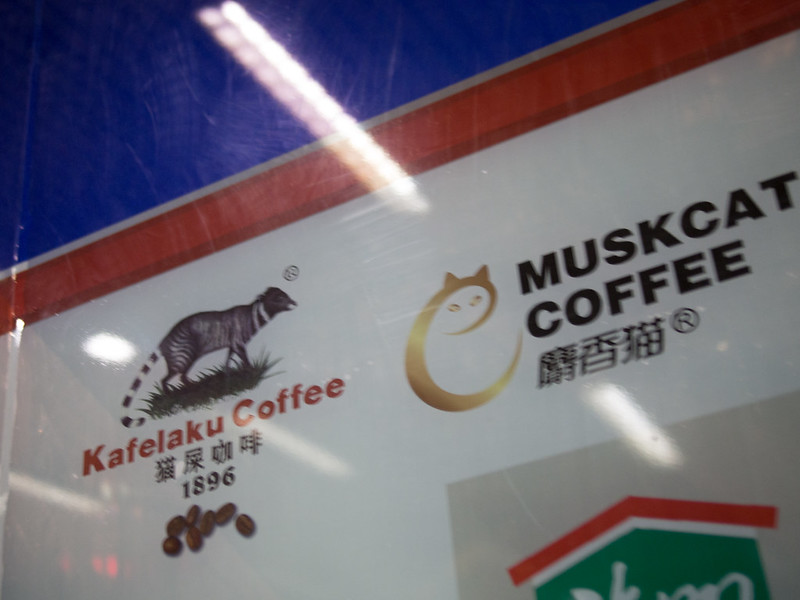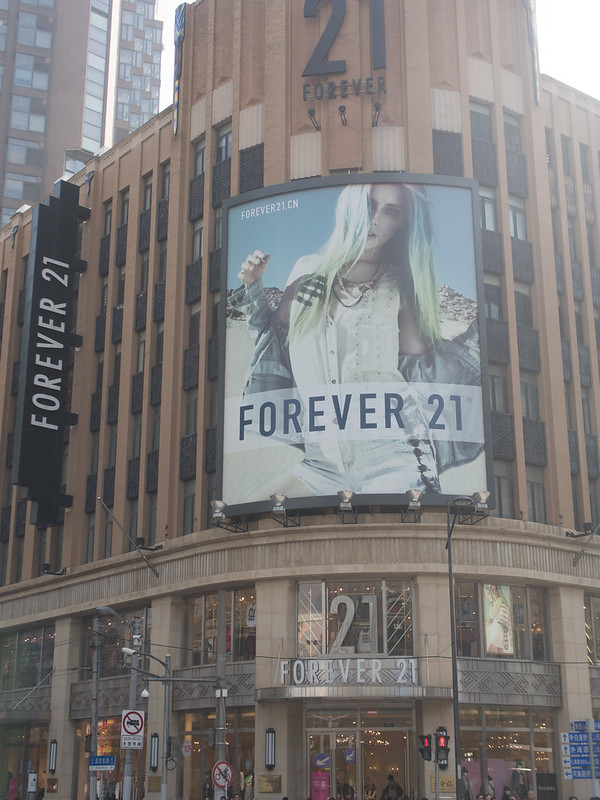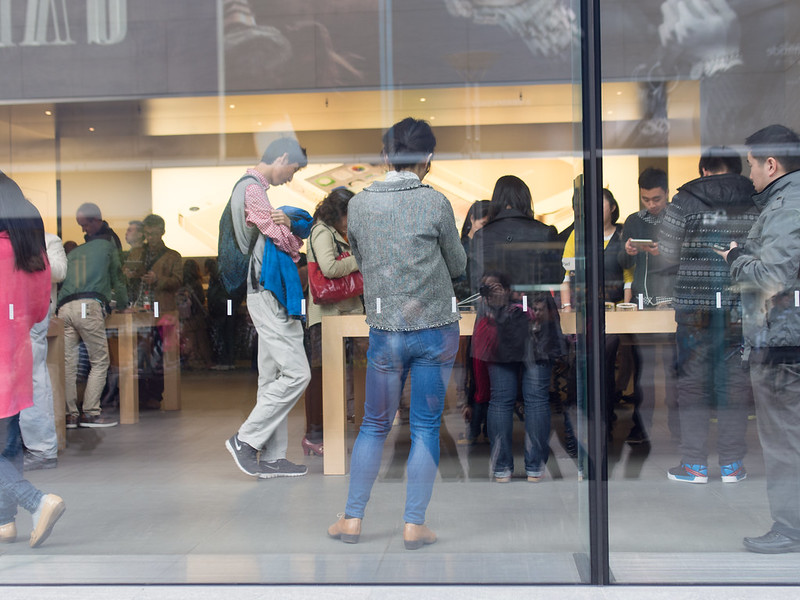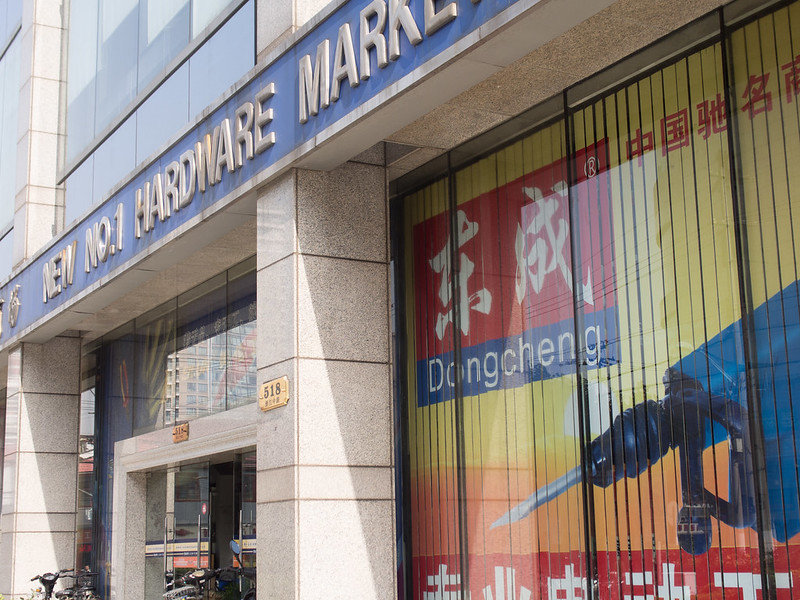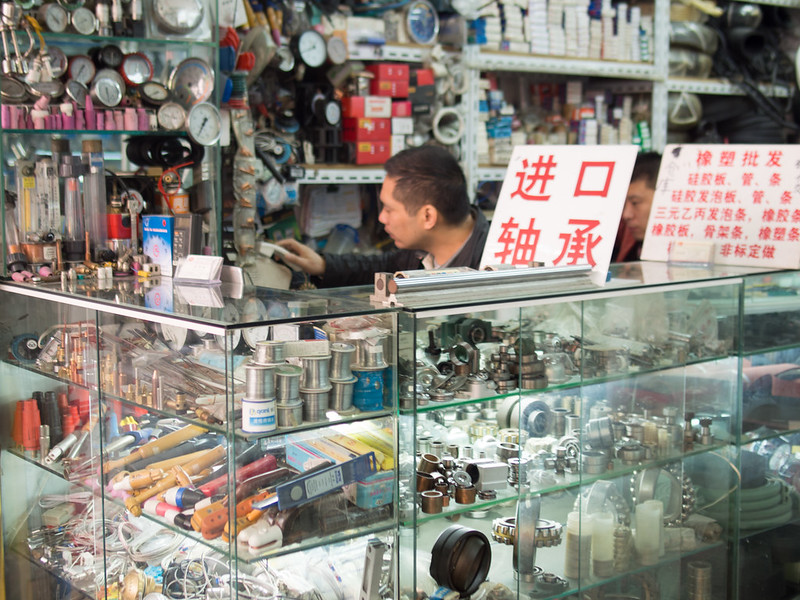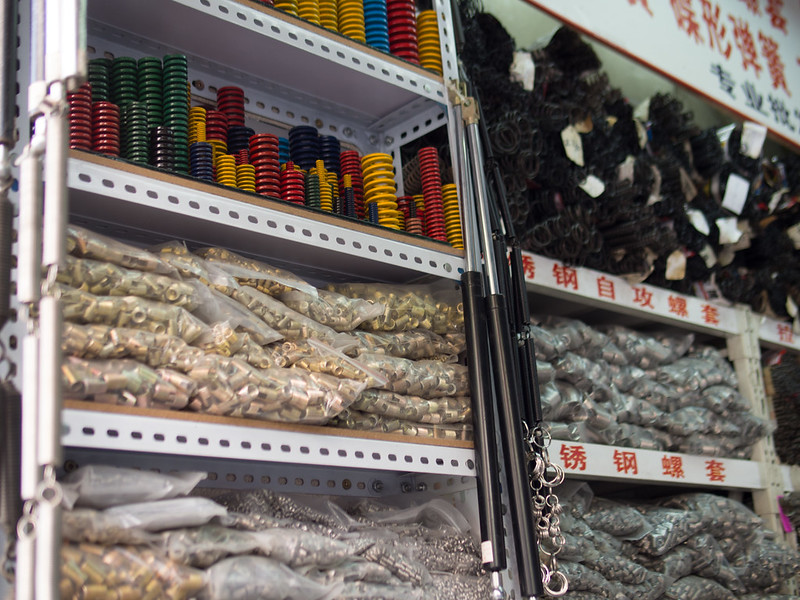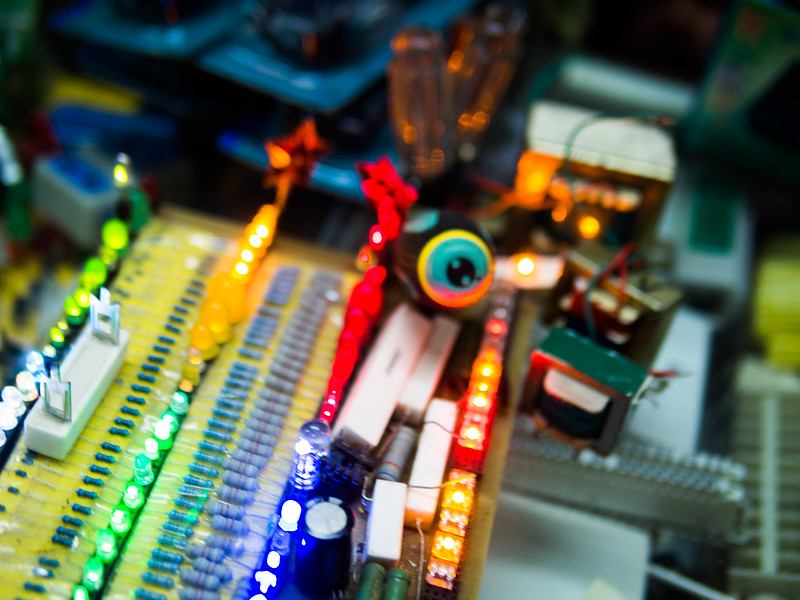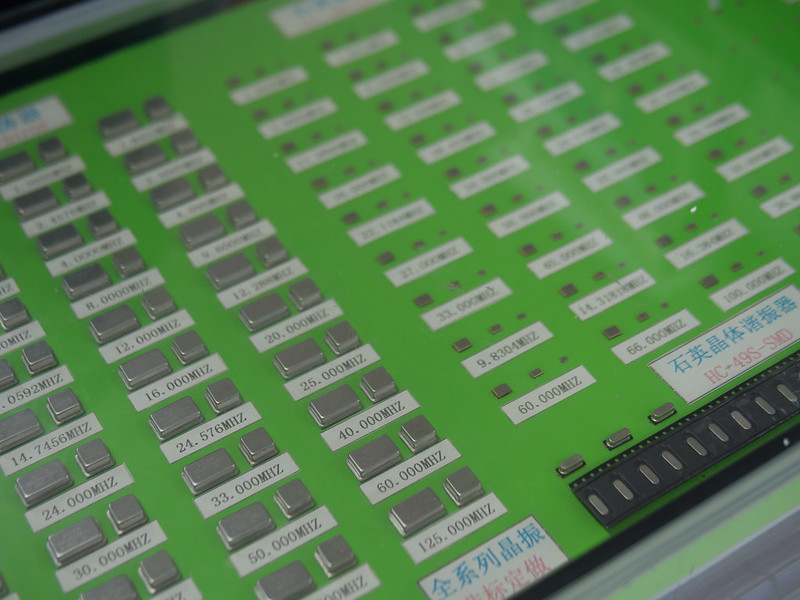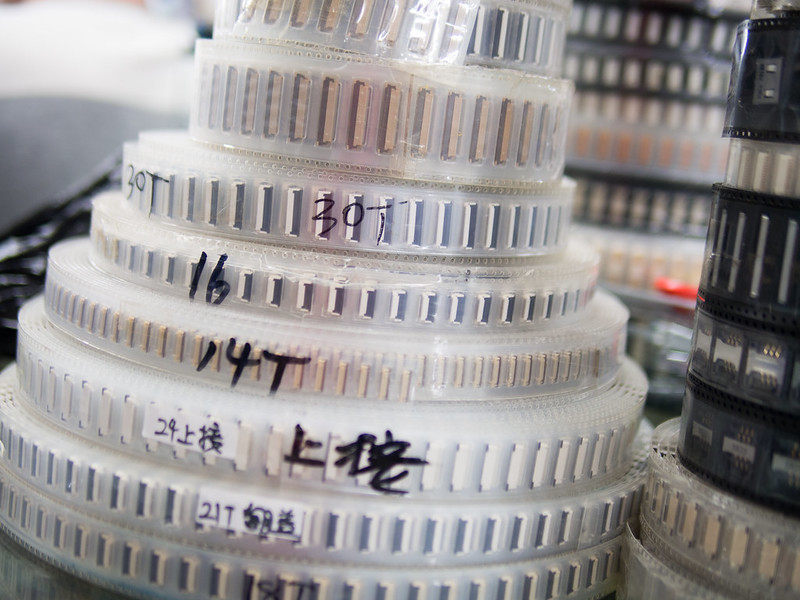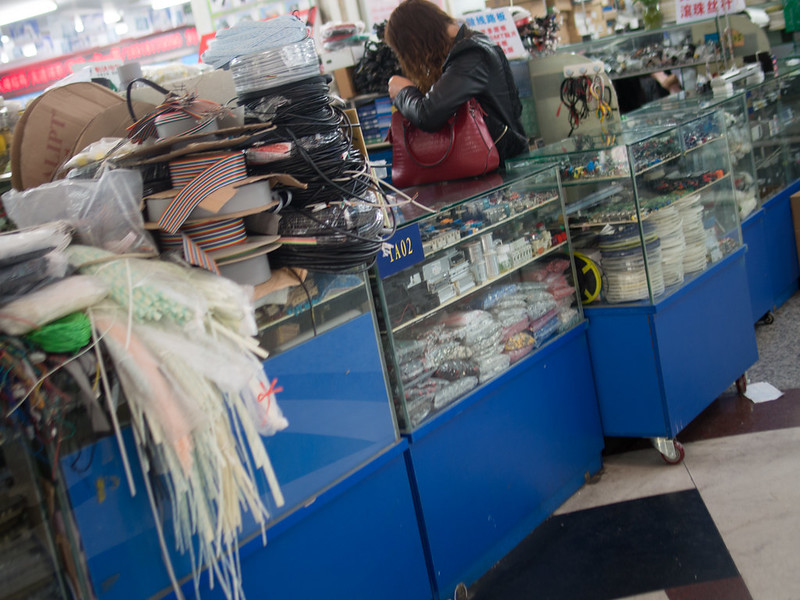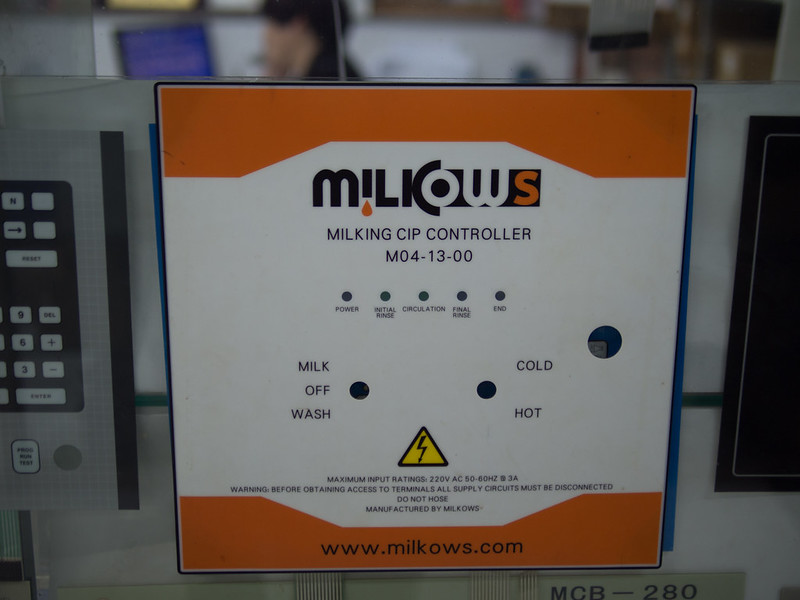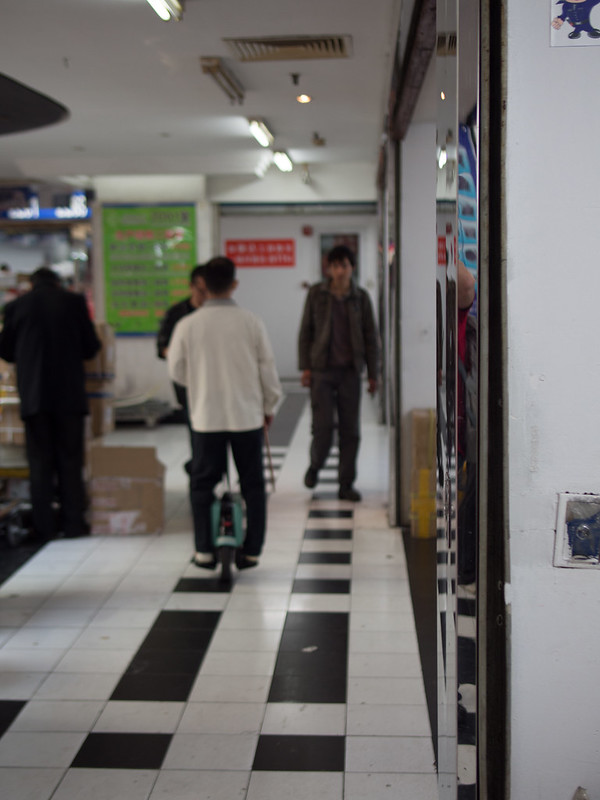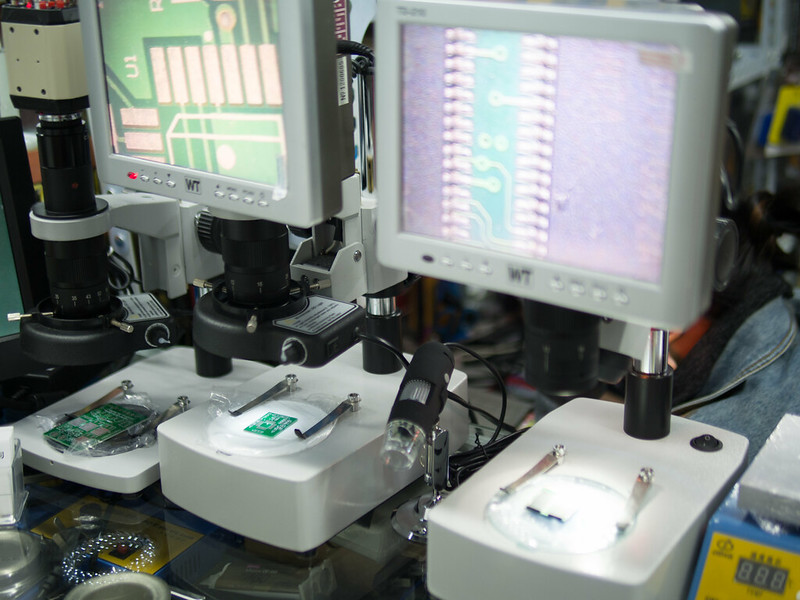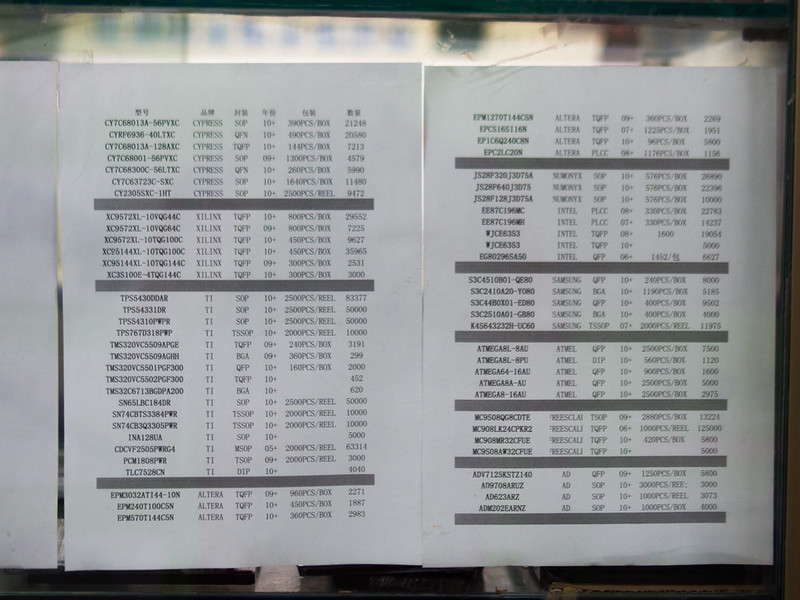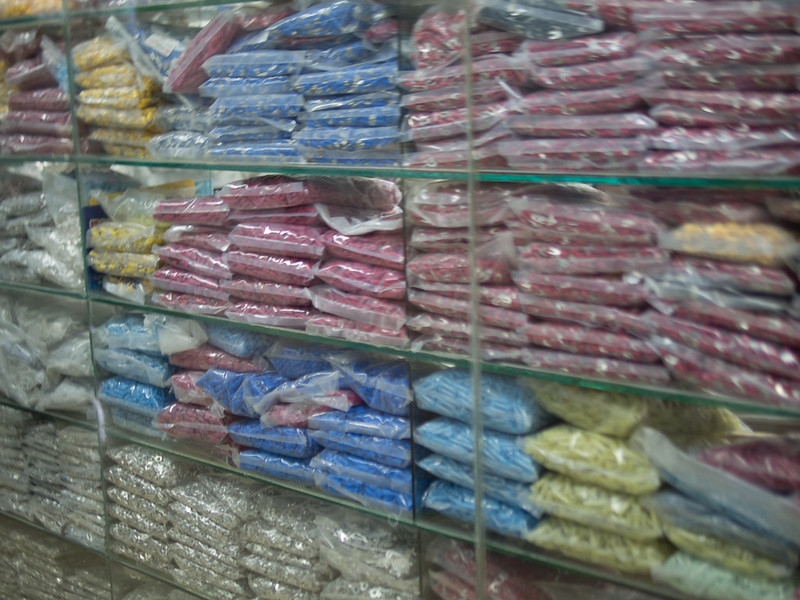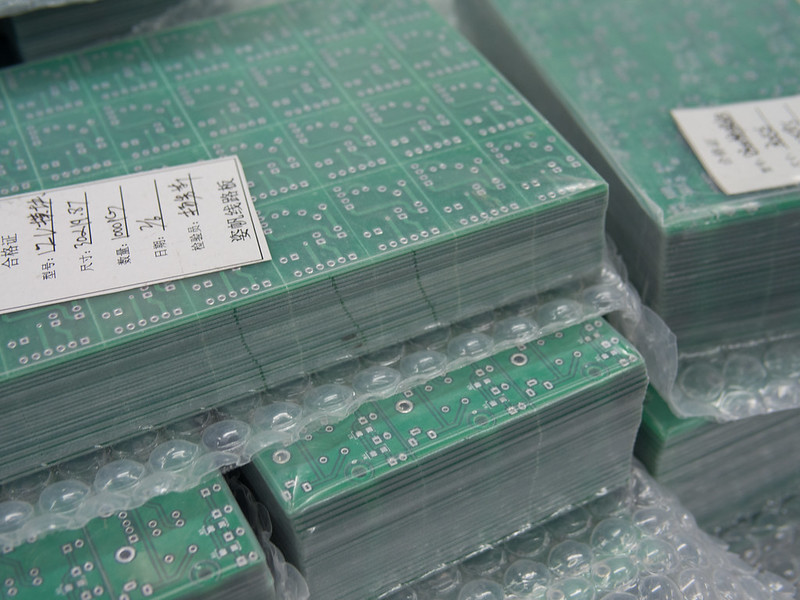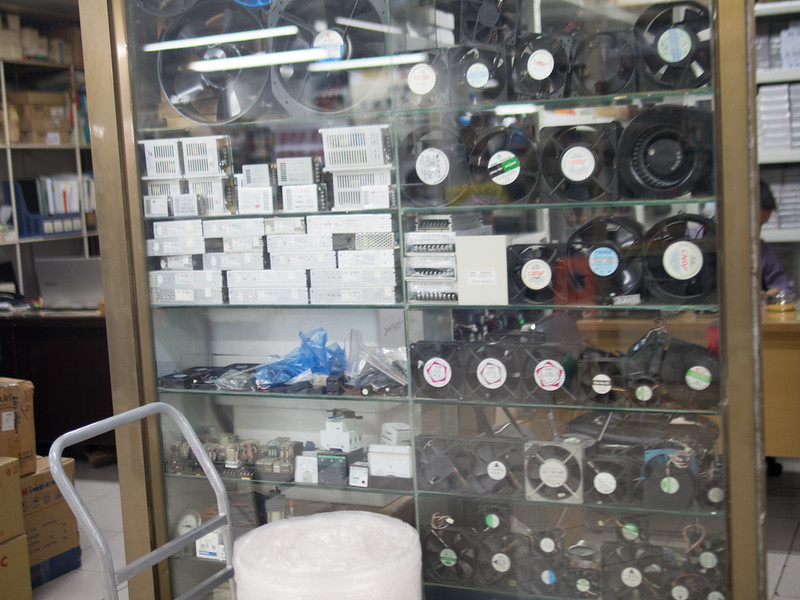This was my third trip to Shanghai. The first one was in 1993. The second was in 2010. Things had changed less between the two most recent trips than between the first two trips. That's hardly surprising.
The first time I flew into Shanghai, My dad and I flew into Hongiao Airport, took a taxi to the decaying Peace Hotel on the Bund and crashed out for 12 hours. Across the river was the Oriental Pearl TV Tower ...and not much else.
When we woke up, we started making our way through the legions of blue-grey-suited pedestrians and cyclists thronging Nanjing Road.
We found ourselves in front of a crowded little dumpling place on a side street. After observing for a bit, we figured out the system: hand over some cash and get issued plastic tokens. Push your way through the crowd to the kitchen counter and hand over your tokens in exchange for delicious looking fried dumplings. We were starving. So we pantomimed that we wanted six dumplings. (Counting on your fingers in Chinese is different than in English. You can get to 10 on one hand.) We got our six tokens. They were an impossibly cheap 20 cents or so. We pushed our way up to the counter and handed them over. The cook started shoveling little greasy fried balls of pork and deliciousness into a paper bag. He didn't stop at 6. He didn't stop at 7. He didn't stop at 8. Eventually we figured out that we'd bought six orders of four dumplings. Despite our best efforts, we only got through about 20 of them before sharing our bounty with a homeless guy in a park.
I remember wandering through dusty, sleepy department stores on Nanjing Road. I found the electronics counter tucked away on the 2nd or 3rd floor. A small box caught my eye. It looked a little like the Gameboy I'd left at home. I was delighted to discover that it was an unlicensed implementation of Tetris that I could almost fit in my pocket.
From Shanghai, we set out across what felt like a very broad swath of Eastern China by hard-seat train. My only memory of Shanghai's main train station is one of low ceilings, signs showing that explosives and fireworks were prohibited on trains and big X-Ray machines for EVERY piece of luggage. The security staff gestured that we didn't need to scan our bags and just waved us through.
The second time I was in Shanghai was Christmas 2010. Kaia and I flew into the giant super-modern PuDong airport. From there, we paid a pittance to take the Maglev train into downtown PuDong - the mega-city that the Chinese government built by fiat in what had basically been rice paddies on my first trip to Shanghai.
We stayed at what was nominally a new-construction Sheraton in Pudong. They upgraded us to a two-room suite on a high floor with a glorious view of the bridges spanning the river and the Bund.
At one point, I went looking for 'interesting' electronics. The recommendation I got put me at what I can only describe as an electronics fake market. I was looking for an interesting Android tablet or something. When I asked about Android phones, I was handed an 'Android iPhone! Dual-SIM!' - It looked sort of like an iPhone. The OS it was running was a dumbphone OS upgraded with ripped icons from iOS and support for a resistive touchscreen. The only Android 2.x tablet I was shown...did not boot. Nor did any of the 4 others they took out of plastic wrap to try to demo. Eventually, the salesperson apologized and said she couldn't show me a working one. In general, though, there was relatively wide availability of high-end tech. When we visited the Super Brand Mall, Best Buy had the relatively complete, if uninspiring selection of gear you'd expect to find at a Best Buy. An underground Apple Store (that wouldn't look out of place in New York or San Francisco) was situated in the next mall over. Across the street from the two malls was the Oriental Pearl TV Tower. Underneath the tower was a sort of awesome but incredibly kitschy museum of the history of Shanghai.
Locals were fairly brand-conscious. Sure, I was offered a fake Rolex, but the tout offering it had stationed himself in front of the Rolex shop on Nanjing Road, a few blocks from American Apparel's China flagship store.
The phrase I use to sum up my impressions of late 2010 Shanghai is 'Starbucks across the street from another Starbucks.'
But this was supposed to be my 2013 Shanghai travelogue.
The view from the airport lounge where I scrambled to install Chrubuntu on my Chromebook.
I'm going to skip over the gory details of my IT setup for this trip -- that's a subject for another post. The very short version is that I arrived with a Google-flavored HTC One with my regular T-Mobile SIM and an ARM Chromebook running Chrubuntu. On my phone, I had access to Twitter and Foursquare. Both devices were signed into a throwaway Google account.
I arrived, somewhat bedraggled, at PuDong airport. I turned on my phone and was greeted by an SMS telling me that international data roaming in China would be rate-limited to EDGE speeds but would be free. Yay T-Mobile!
The next thing my phone told me was that in the 14 hours I'd been offline on my way to china, updates for a dozen or so Google apps had been uploaded to the Play Store. It was almost certainly a coincidence.
I decided that given how tired I was, I could treat myself to a taxi. I spent a few minutes stumbling around the arrivals hall of the airport looking for an ATM. A liveried driver hanging out at an official looking 'Ground Transfers' desk tried to convince me that she'd offer me a much better rate to the hotel than the hotel's airport transfer service. She quoted a number approximately 3x what a cab was supposed to cost. When I told her what a cab cost, she looked a little disappointed, said 'taxis are downstairs' and wandered off.
Dear San Franciscans - the Shanghainese have developed artificial fog technology and may soon put @carlthefog out of business
Stepping out of the airport, I walked into a wall of air. At least it felt that way. It was insanely smoggy. I didn't find out until later that it had been 'keep the kids and grandparents inside, halt construction projects and ban fireworks' smoggy. The cab ride was uneventful. I'd printed a copy of the Chinese-language driving directions from the airport to my hotel during my downtime at the airport in Chicago.
Some of the drive from PuDong to Shanghai felt like driving through a megalopolis. Some of it felt like driving through a post-apocalyptic wasteland.
I spent the trip splitting my attention between marveling at the endless tracts of buildings across PuDong, Friday afternoon traffic and an email conversation with Thomas Yao,the leader of the Shanghai Linux Users' Group. I was pretty shattered, but Thomas talked me into going out for dinner with him later in the evening.
The cab pulled up at the Sheraton Hongkou, which I'd picked because it had an astonishing promo rate and was located across the street from a subway station on the Shanghai side of the river. What I hadn't realized at the time was that it was a brand new skyscraper in an area that was otherwise completely un-redeveloped.
The Sheraton was...well, it was a very, very nice Sheraton. From the bedroom-sized shower with a claw-foot tub and a view of downtown Shanghai to the heated marble floor by the sink and the french press for coffee and the $10 bottle of Evian, it was what you'd expect.
Heading out for dinner with Thomas, I asked the front desk if the RFID transit card I had in my wallet was a Shanghai subway pass. He told me he thought it was, but wasn't sure. It didn't work, so I bought a 40 cent subway ticket to Thomas' office on the Pudong side of the river.
Coming out of the subway, there was a small flea-market, consisting of sweaters, nuts, roasted snacks and iPhone cases. So many iPhone cases.
I walked into the GitCafe office to find Thomas and one of his coworkers playing XBox soccer on a giant wallscreen. They finished up their game, we chatted a bit and Thomas and I headed off for dinner. I asked him about the RFID card the clerk thought might be a Shanghai subway card. Thomas pointed out the large text that said '北京' (Beijing) before helping me buy an actual Shanghai subway pass.
The old TV tower got a new lease on life as the host of the hourly laser show.
We had dinner at 代官山, one of Thomas' favorite restaurants at Super Brand Mall. Very few parts of dinner were things I recognized, but everything was tasty. One of the oddest bits was the drinks, which were some sort of Coca-Cola and citrus concoction with tiny little citrus fruits served in glass bottles heavy enough to kill someone. As we were leaving the mall, the Oriental Pearl TV Tower lit up with a laser light show. Green laserbeams started hitting nearby buildings and giant laser-projected horses stampeded across the tower's base.
Some of the local cafe chains have made fascinating branding choices.
We made plans to meet up Wednesday evening at XinCheJian, the local hackerspace. From there, I headed home and passed out until morning.
Consumerism!
Saturday, I set off to find the Beijing Street electronic components market Thomas had recommended to me. It was fairly near Nanjing Road, so I hopped on the subway and popped up in front of the Sony Store and a gigantic Forever 21. Across the street was the first block of the Nanjing Road pedestrian mall. As soon as I set foot on the pedestrian mall, the touts hit. "Hey Mister. You want a watch?" "No." "You want a handbag?" "No." "Massage?" "No." "Lady massage? Very sexy girls." "No." And it didn't let up. From there on in, if I was on Nanjing Road, a tout was trying to sell me a Rolex, a designer handbag or a happy-ending massage. Some of the touts were men. Some were women. All were reasonably young. Some were more aggressive about it than others. Some only got in a single question as I walked past. Others followed me for half a block. That's the last I'll mention of the touts.
Just like home!
I walked down Nanjing Road for a couple blocks -- past a mobbed Apple Store, a gourmet grocery store, Gucci and a bunch of other high-end western shops. Guided by Google Maps, I took a right toward Beijing Road. Things quickly became more chaotic. Sidewalks and traffic lights became more...advisory than anything else. The side street was lined with small local shops, restaurants and...sort of ramshackle holes where there should be more shops.
Seconds before, this shop window had been shilling for DeWalt
As I hit Beijing Street, things changed again. Apparently that section of Beijing Street is known as 'Hardware street.' On the corner as I walked up was a sort of micromall of power tools, hand tools and gas generators. Some of the stuff there was from Chinese brands I'd never heard of like Dongcheng, but there was just as much stuff (and advertising) from DeWalt, Craftsman and Milwaukee.
Plumbing supplies on Beijing Street
Perhaps I could interest you in some industrial springs in a range of festive colors?
Walking down Beijing Street, there were whole stretches of shops that sold nothing but magnets or bearings, tubing, connectors or brushes. Across the street, I found the 7 story "Technology Jingcheng Electron Market".
Every kiosk also sold a range of diodes, capacitors, oscillators and so on, but they weren't nearly as photogenic.
See. Told you so.
I started by wandering in the front door. A few dozen kiosks filled almost all available floor space. The kiosks had demos of the various LEDs they had for sale. They also appeared to sell everything else. Under glass various kiosks had piles of different sorts of switches, diodes, ICs, power adaptors, LCDs and a variety of other parts.
Some of the kiosks were filled with unstable stacks of partial reels of surface-mount components.
And kids. Kids everwhere. It was Saturday, so everyone just brought their babies, toddlers and 10 year-olds to hang out.
Every kiosk had one display case on wheels that served as a door..of sorts.
Heading downstairs into the basement, I found more of the same, but also a little more work being done. A few shopkeepers had customers laptops open and were attacking their motherboards with soldering irons. Things in the basement were generally a bit better organized than on the first floor.
If you need custom faceplates for your milking machines, this is the place to go.
The second floor was...probably about 50% bigger than the first floor and connected to the next building over. As I was doing the tour of shops that sold nothing but spools of surface-mount microcontrollers (and there were probably about 20 of them), women with small sheafs of paper listing the parts their clients needed would dart in an out of various shops placing or picking up orders.
At some point, a guy on a powered self-balancing unicycle zoomed past me.
I wouldn't realize it was odd until days later, but not a single person on any of the 5 occupied floors of the component market said a single word to me without me trying to start a conversation first. And I only did that twice.
I seriously considered trying to bring one of these soldering station microscopes home in my suitcase.
I make keyboards. I hadn't really thought about buying keyboard parts on this trip. Had I planned ahead, I could have gotten someone at the electronics market to design me a PCB for my next model. As I was walking around, I kept an eye on the keyswitches that were being offered for sale, on the off chance that someone had a good deal on the switches I use (or interesting alternatives). Somewhere on the third floor, I finally found someone selling Cherry keyswitches. The vendor didn't speak any English (and, to a first approximation, I speak no Chinese.) Using Google Translate, I explained that I wanted to know how much 200 of those keyswitches would cost. One of the two folks behind the counter picks up the switch I wanted and ran off. About 10 minutes later, he turned up again and wrote down a price...which was easily twice what they should cost. I wrote down what I wanted to pay. He shook his head, made an X with his arms and turned away from me. As I walked away, he was taking cameraphone pictures of the keyswitch.
Very, very few of the vendors had posted price lists like this one.
There were three of these shops in a row
The higher floors of the central market held more and more 'finished' goods. The shops in the secondary building tended to sell only a single sort of thing. There were bubblewrap shops. There were X86 CPU shops. There were packaging shops. There were shops that only made faceplates. There were cabling shops. You get the idea.
I got all the way to the top of the market without finding another vendor selling keyswitches. There had to be one -- the merchant with the high price really clearly hadn't left the building when he'd run off to get me a price. But it was lunch time and I was a little burned out on electronic components.
If I'd been planning ahead, I probably could have gotten some keyboard PCBs made while I waited.
As I was walking across the second or third floor to get to the escalator, I noticed a tiny, tiny little kiosk (maybe 3 feet square) that had some keycaps on their "what we sell" board. Looking closer, they had an awful photocopy of the data sheet for Cherry keyswitches taped to the front of their display case. Getting into a conversation with the seller, it turned out that she had a pretty reasonable selection of Cherry keyswitches and keycaps. Her pricing for keyswitches was among the best I've found anywhere, though I know she was still making a decent profit. Her pricing on keycaps was astonishingly good for what she was selling. So I can find it later, her email is 724371693@qq.com and her phone is 021-53083556. The website on her business card doesn't exist. I walked out about $60 poorer, but 200 Cherry keyswitches and about 700 keycaps richer.
Over the course of the morning, I became a big fan of the Beijing-lu Electronic components market.
It was time for lunch.

